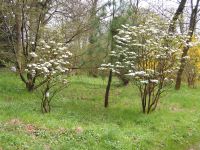scarlet leaved viburnum - Viburnum furcatum
English name:
scarlet leaved viburnum
Scientific name:
Viburnum furcatum
Family:
Adoxaceae (Adoxa family)
Height:
up to 4 m.
Flowering:
Late April early May
Range:
Japan, Korea, Russia (South Sakhalin and South Kurils)
 |
 |
The two 25-year-old Viburnum furcatum bushes n the picture can be found by the Lake road in the Arboretums collection of Ash trees, in square 1307 position 2826.
Plant description:
The genus Viburnum comprises about 150 species (3 in Europe) within the Adoxa family (many place this genus in the Caprifoliaceae family). The genus has a very broad natural range in Europe, Asia and North America and furthermore is reported to also spread into Malaysia and S. America. All are shrubs or small trees with opposite leaves and fleshy fruits (one-seeded drups) some can be eatable but some are poisonous depending on species. The wood of some species has been used to make arrow shafts both in Europe and North America (for example found with the neolithic Iceman from the Alps). Some species, like the one describe here have enlarged marginal flowers that are sterile but attract pollinators (and plant collectors). The Arboretum collection contains 29 species of Viburnum and has 9 examples of Viburnum furcatum from Japan and Korea.
Viburnum furcatum is a component of the Fagus crenata climax forests in the mountains of Japan, and thus not surprisingly, can tolerate shady conditions. The showy inflorescences are produced abundantly even in our bushes growing under a rather dense birch canopy. The heights of our bushes have reached 4 meters in the shade and about 2 meters in full sun. It is one of the species that brightens up the Arboretum in the early spring with its brilliant white, showy flowers. The fruits are red and then eventually turn black. To get the decorative fruits however, it is necessary to have several plants, as this species is self-sterile. Viburnum furcatum is reported to be first introduced into Denmark sometime before 1931. Our oldest specimens (2-4 m tall) germinated in 1977.
Leaves are opposite, 7-15 cm broadly ovate with indented veins, and with a heart shaped base. The foliage is reported to turn brilliant red in the autumn. Flowers occur together in a flat inflorescence with large showy marginal flowers. Distinctive characters for the species (compared with V. alnifolium) are: the early flowering, upright habit, stamens which are only half as long as the corolla and the broad furrow on the seed (furcatum = cleft).
References:
Rehder, A. 1947. Manual of Cultivated Trees and Shrubs Hardy in North America.The Macmillan Co., New York. Pp 830-835.
Bean, W.J. 1976. Trees and Shrubs Hardy in the British Isles. Vol IV. 8th edition, The Royal Horticultural Soc. Publisher pp. 704.
Lange, J. 1994. Kulturplanternes Indførelshistorie i Danmark. (Introduction History of Cultivated Plants in Denmark). Jordbrugsforlaget, Frederiksberg C.
